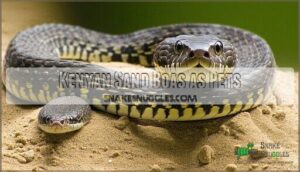This site is supported by our readers. We may earn a commission, at no cost to you, if you purchase through links.

Beginners should focus on docile species like corn snakes or ball pythons that tolerate handling well and don’t require complex care. Consider factors like adult size, feeding requirements, and lifespan—some snakes live 20+ years.
Your living situation matters too; apartment dwellers need smaller species, while homeowners have more flexibility. Budget for initial setup costs plus ongoing expenses like food, heating, and veterinary care.
Don’t rush the decision—the wrong snake becomes a costly, stressful mistake. Smart preparation and species research reveal surprising insights about which serpent truly matches your situation, and helps you make an informed decision about your new pet and its lifespan.
Table Of Contents
- Key Takeaways
- Choosing The Right Pet Snake
- Top Beginner-Friendly Snake Species
- Factors to Consider Before Buying a Snake
- Choosing The Best Snake for Handling
- How to Get Your Pet Snake
- Preparing for Snake Ownership
- Snake Care and Health Considerations
- Frequently Asked Questions (FAQs)
- Which snake is right for me?
- How to pick the right snake?
- What’s the friendliest snake to have as a pet?
- What kind of snake is good for a first time owner?
- How do I choose the right snake?
- What is the friendliest snake to have as a pet?
- What is the best snake for a first time owner?
- Which snakes like to be handled?
- How often should I replace the snakes bedding?
- Are snakes noisy compared to other pets?
- Conclusion
Key Takeaways
- Match your experience level to the right species – If you’re a beginner, stick with docile options like corn snakes or ball pythons that forgive mistakes and handle well, rather than jumping into advanced species that’ll stress you out.
- Consider your long-term commitment seriously – You’re signing up for 15-30 years of care, feeding frozen rodents, and maintaining precise habitat conditions, so make sure you’re ready for decades of responsibility.
- Budget for ongoing costs beyond the initial purchase – Factor in monthly food expenses ($5-15), annual vet bills ($100-300), heating costs, and potential enclosure upgrades as your snake grows.
- Prioritize space and lifestyle compatibility – Apartment living works better with smaller species like rosy boas, while your daily schedule needs to accommodate consistent temperature monitoring and feeding routines.
Choosing The Right Pet Snake
Choosing the right snake starts with understanding your experience level and what you’re looking for in a pet.
You’ll want to match a snake’s temperament, size, and care requirements with your lifestyle to guarantee both you and your new companion will be happy together.
Understanding Snake Temperaments
Snake temperament-testing becomes your roadmap to the perfect pet match. Each species brings distinct personality traits that affect handling ease and daily interaction levels.
- Watch defensive behaviors – hissing, coiling, or rapid retreating signals a more reactive snake temperament
- Identify comfort signs – relaxed posture and calm tongue-flicking indicate docile temperament suitable for snake handling
- Match species temperament – corn snakes offer beginner-friendly snake behavior while others require advanced experience. Some snakes, like the Ball Python, are popular due to their unique color morphs.
Researching Snake Breeds and Characteristics
Before diving into snake ownership, research is your best friend.
Different snake species vary dramatically in snake size (from 2-foot rosy boas to 15-foot pythons), lifespan expectations (10-50 years), temperament traits, diet specifics, and habitat needs.
Understanding these characteristics helps match the right snake species to your experience level and living situation, ensuring you’re prepared for decades of commitment.
Some species even have adaptations like heat-sensing pits to detect prey.
Considering Your Lifestyle and Experience Level
Time commitment varies dramatically across snake species.
If you’re juggling work and family, beginner-friendly species like corn snakes need minimal daily care.
Space constraints matter too—cramped apartments suit smaller snake species better than massive pythons.
Budget planning includes ongoing costs, not just initial purchases.
Most importantly, experience matching guarantees success.
First-time owners should choose docile beginner snakes with forgiving temperaments.
Lifestyle compatibility means honest self-assessment: can you handle frozen mice and handling experience requirements?
Your perfect snake matches your reality, not your wishlist.
Popular Snake Breeds for Beginners
After considering your lifestyle, you’ll want to choose from proven beginner snake species that match your comfort level.
These docile snake options offer excellent handling ease while requiring minimal experience. The best pet snake for you depends on size matters preferences and your commitment to beginner care.
Understanding a snake’s anatomy and physiology can also help owners provide better care. Learn snake care to guarantee your new pet thrives.
Consider these low maintenance snakes:
- Corn snakes – Colorful, gentle, and forgiving with mistakes
- Ball pythons – Calm temperament variety with stunning patterns
- Rosy boas – Small size, easy to care snakes perfect for apartments
- Kingsnakes – Hardy and curious, ideal for interactive owners
Top Beginner-Friendly Snake Species
Now that you know what to look for in a snake, let’s explore the best beginner-friendly species that’ll match your experience level and lifestyle.
These five popular choices offer the perfect balance of manageable care requirements and rewarding companionship for new snake owners.
Corn Snakes as Pets
If you’re looking for the perfect snake for beginners, corn snakes might just be your best bet.
These colorful reptiles are famous for their beginner friendliness and calm temperament traits. You’ll find corn snakes surprisingly easy to handle, rarely showing aggression or defensive behavior.
Their feeding habits are straightforward—they readily accept frozen-thawed rodents without the fussy eating patterns some species display.
What makes corn snakes stand out among beginner snake species:
- Cornsnake morphs offer stunning variety, from vibrant oranges to subtle pastels, letting you choose a visually appealing pet
- Enclosure enrichment needs are simple—basic hides, water bowls, and climbing branches keep them content
- Docile snake breeds don’t get much calmer, making handling sessions stress-free for both you and your snake
These easy to care snakes adapt well to different environments and forgive minor husbandry mistakes while you’re learning the ropes.
Ball Pythons as Pets
Ball pythons earn their reputation as the "gentle giants" of beginner-friendly snakes.
These docile temperament champions rarely bite, making ease of handling their strongest trait.
You’ll find over 7,500 ball python morphs available, from stunning pastels to striking piebalds.
Their feeding habits involve frozen-thawed rodents every 1-2 weeks, though occasional hunger strikes require patience.
Temperament training isn’t necessary—they’re naturally calm.
Watch for health concerns like respiratory infections and mites.
| Physical Traits | Care Level | Personality |
|---|---|---|
| 3-5 feet long | Moderate humidity needs | Defensive coiling |
| Sturdy build | Weekly feeding | Rarely aggressive |
| 30+ year lifespan | Enclosure enrichment | Handleable nature |
Rosy Boas as Pets
Rosy boas make excellent starter snakes with their docile temperament and beginner-friendly care requirements.
These calm serpents stay comfortable in small spaces, reaching just 2-4 feet as adults.
- Rosy Boa Enclosure Size: Compact terrariums work perfectly
- Rosy Boa Diet: Frozen mice every 1-2 weeks
- Handling Rosy Boas: Gentle, low-maintenance interactions
- Rosy Boa Lifespan: 20+ years of companionship
Kenyan Sand Boas as Pets
Kenyan sand boas make excellent beginner pets with their naturally docile temperament and straightforward care requirements.
Their compact size rarely exceeds two feet, making enclosure size manageable with just a 30-gallon tank.
Their unique burrowing behavior requires deep sandy substrate options, creating fascinating viewing opportunities.
Their reliable feeding habits and beginner friendliness shine through consistent appetite and minimal fuss during meals, establishing them as ideal choices for new reptile pet ownership adventures.
Kingsnakes as Pets
Kingsnakes stand out among nonaggressive snakes with their curious, friendly nature.
These active snakes enthusiastically explore their environment, making snake habitat setup with enclosure enrichment vital.
Their reliable feeding habits and manageable snake temperament create an ideal match for beginners learning proper snake care and handling techniques.
Here are four key kingsnake benefits:
- Diverse Kingsnake Morphs – California, Mexican, and Florida variants offer stunning color options
- Easy Feeders – Readily accept frozen/thawed rodents without fussing
- Active Personality – Often visible during day, unlike shy king snakes species
- Escape Artists – Require secure, escape-proof housing for safety
Factors to Consider Before Buying a Snake
Before you bring home your first snake, you’ll need to honestly assess whether you’re ready for a 10-30 year commitment that includes feeding frozen rodents and maintaining precise habitat conditions.
The decision goes beyond just picking a cute snake – you’re choosing a long-term responsibility that affects your daily routine, budget, and living space.
Commitment to Caring for a Pet Snake
Owning a snake typically means long-term commitment spanning 15-30 years.
You’ll handle daily spot cleaning, weekly full enclosure maintenance, and regular vet visits.
This lifestyle change affects your entire family, requiring consistent temperature monitoring and feeding schedules.
Consider the financial responsibility and ethical considerations before committing to decades of specialized snake care.
Overall Costs of Snake Ownership
Smart budgeting prevents ownership surprises down the road. Your initial investment covers the snake, enclosure, and basic equipment, while recurring expenses include food and utilities.
Budget smart – surprises cost more than preparation ever will.
Don’t forget about potential veterinary costs and future enclosure upgrades as your snake grows.
- Initial investment ranges from $100-$1,500 depending on species and setup quality
- Food costs average $5-$15 monthly for frozen rodents bought in bulk
- Veterinary costs require budgeting $100-$300 annually for check-ups and emergencies
- Enclosure upgrades become necessary as snakes outgrow their current habitats
Safety Precautions for Snake Handling
Before you bring your new snake home, prioritize safe handling practices to prevent accidents.
Use proper handling techniques like snake hooks for moving and supporting the snake’s body.
Approach slowly to minimize defensive behaviors and bite prevention.
Follow hygiene practices by washing hands after contact.
Make certain child safety through adult supervision.
Never attempt keeping venomous species without professional training.
| Safety Aspect | Best Practice |
|---|---|
| Snake Handling Tips | Use hooks, move slowly, support body weight |
| Handling Anxiety | Start with short sessions, build confidence gradually |
| Bite Prevention | Avoid sudden movements, watch for stress signals |
| Hygiene Practices | Wash hands thoroughly, disinfect equipment regularly |
| Child Safety | Always supervise minors, teach proper techniques first |
Choosing The Right Enclosure and Equipment
Your snake’s home isn’t just a box—it’s their entire world. Getting the right setup means thinking beyond basics to create a comfortable, secure environment.
- Enclosure Size: Choose tanks allowing full stretching; 4-foot snakes need 4-foot minimum lengths. Understanding appropriate tank dimensions is essential for your snake’s well-being.
- Heating Systems: Install proper temperature gradients with thermostats for safety and control
- Humidity Control: Use monitors to maintain species-specific moisture levels between 40-60%
- Substrate Options: Select easy-clean materials like aspen or coconut fiber supporting natural behaviors
- Enrichment Items: Add hiding spots, climbing branches, and water bowls for mental stimulation
Meeting Specific Snake Care Requirements
After choosing your enclosure and equipment, you’ll need to master the daily care basics that keep your snake healthy and content.
Meeting your snake’s care requirements means staying on top of several key areas:
- Temperature Gradients – Maintain proper heat zones with cool sides at 70-75°F and warm sides at 80-85°F
- Humidity Levels – Keep species-specific moisture between 40-60% for most beginner-friendly snake species
- Dietary Needs – Feed appropriate prey every 1-2 weeks based on your snake’s size and species
- Enclosure Enrichment – Provide hiding spots, climbing branches, and exploration opportunities
- Veterinary Checkups – Schedule regular health monitoring with reptile-experienced vets
These snake care requirements aren’t negotiable—your snake depends on you getting them right every single day.
Choosing The Best Snake for Handling
If you’re hoping for a snake that won’t turn handling time into a wrestling match, it’s smart to pick a species known for calm temperaments.
Choosing the right snake makes it much easier to enjoy safe, relaxed interaction—no need to worry about surprise acrobatics or a disappearing act under the couch.
Snake Handling Safety and Etiquette
Proper snake handling techniques protect both you and your pet. Always wash your hands before and after contact – hygiene practices prevent disease transmission.
Support the snake’s body mid-section, never grabbing just the head or tail.
| Do This | Avoid This |
|---|---|
| Move slowly and calmly | Quick, jerky movements |
| Support the snake’s weight | Grabbing head or tail only |
| Wash hands before/after | Handling during shedding |
| Use confident grip | Squeezing or restraining |
Watch for stress signals like rapid breathing or defensive coiling. Limit handling frequency to 2-3 times weekly maximum.
Children need constant adult supervision for child safety. Understanding bite prevention starts with recognizing when your snake feels threatened.
Selecting a Snake That Enjoys Being Handled
Now that you’ve got safety down, let’s talk about picking a snake that’ll actually enjoy your company. Think of it like choosing a workout buddy—you want someone who won’t bolt the moment you show up.
Docile Snake Breeds make the best handling companions. Here’s your lineup of snake superstars:
- Corn snakes – These guys are the golden retrievers of the snake world, with calm temperament and tolerance for regular interaction
- Ball pythons – Known for their chill vibes and low bite tendency, perfect for building confidence with snake handling techniques
- Rosy boas – Gentle giants that rarely get defensive, ideal for frequent handling frequency
- Garter snakes – When conditioned early, they show excellent temperament indicators and adapt well to human contact
Look for comfortable handling signs like relaxed posture and slow movements. Some boas, like the Rosy Boa, are known for their tolerance to interaction, making them ideal for frequent handling. Different species interaction levels mean some snakes thrive on attention while others prefer minimal contact. Match your desired snake handling style with breeds known for their snake temperament.
Taming a New Snake to Handle
In the context of taming a new snake, think of Initial Handling as breaking the ice at a quiet gathering.
Use these handling techniques:
- Start with short, gentle sessions—let your snake explore your hands.
- Gradual Exposure works wonders; increase Handling Frequency slowly.
- Use Positive Reinforcement, like calm words or treats, and always read their signals.
Snake handling gloves for beginners help too!
Importance of Patience and Experience in Handling
The journey from nervous snake owner to confident handler takes time and practice.
Handling experience teaches you to read snake temperament cues and respond appropriately.
Patience and positive reinforcement help you develop gentle temperament techniques that focus on reducing stress and building trust.
This gradual introduction approach maximizes handling benefits while avoiding bites through respectful snake handling.
How to Get Your Pet Snake
When you’re ready to bring home your new scaly friend, you’ll find several ways to get started, from local pet stores to online sellers and even rescue groups.
Take your time, ask plenty of questions, and remember—choosing the right source is almost as important as picking the snake itself (nobody wants a surprise guest hiding in the box).
Local Reptile Pet Stores
Why settle for guesswork when you can examine snakes firsthand? Local reptile pet stores like Petco and PetSmart let you observe temperaments before buying, plus staff can offer expert advice.
- Store reputation matters—read reviews and check cleanliness standards
- Species availability varies, so call ahead about specific breeds
- Expert advice from knowledgeable staff beats online research alone
- Health guarantees protect your investment with return policies
Online Snake Sellers
While local stores offer hands-on shopping, the reptile marketplace online opens vast possibilities.
Top sellers like XYZReptiles and Backwater Reptiles maintain stellar seller reputation through customer reviews.
Research shipping logistics and health guarantees carefully. Verify species verification and consider ethical sourcing practices.
Shipping practices vary, so understand policies before purchasing. Many prioritize animal welfare standards with transparent practices.
| Feature | What to Look For |
|---|---|
| Seller Reputation | Positive reviews, years in business |
| Health Guarantees | Live arrival, replacement policies |
| Shipping Practices | Insulated packaging, weather delays |
| Species Verification | Accurate photos, genetic lineage |
Breeder or Hobbyist?
Beyond online retailers, you’ll find dedicated breeders and passionate hobbyists who specialize in specific snake morphs.
These sources often provide superior genetic diversity, health guarantees, and ongoing support networks that pet stores can’t match.
Here’s what makes breeders and hobbyists special:
- Personal expertise – They know each snake’s lineage and temperament intimately
- Rare morphs – Access to unique colorations you won’t find elsewhere
- Health records – Detailed feeding history and veterinary documentation
- Lifetime support – They’re invested in your success as a snake owner
- Fair pricing – Often better value than commercial retailers
Find local breeders through reptile events and community resources.
Check sellers’ reputation on reptile marketplace online platforms before purchasing.
Quality breeders emphasize breeder ethics over profit margins.
Adoption and Rescue Options
Rescue organizations offer an excellent alternative to buying from breeders or stores. Organizations like Aunt Anna’s Reptile Rescue and The Herps Alive Foundation specialize in finding homes for surrendered snakes.
The adoption process typically involves an application and basic screening to confirm you’re prepared for snake ownership. You’ll often save money while supporting ethical considerations around rehab snakes.
Some of the benefits of adopting from rescue organizations include:
- Access to snakes with known histories and temperaments
- Support from experienced reptile community members
- Cost savings compared to purchasing from sellers
- Opportunity to provide second chances for rescue snakes
- Direct connection with local shelters and rescue networks
Preparing for Snake Ownership
Once you’ve chosen your ideal snake species, it’s time to create the perfect home environment before bringing your new pet home.
Proper preparation means setting up the enclosure, controlling temperature and humidity, and gathering feeding supplies—all vital steps that guarantee your snake’s health and happiness from day one, which is crucial for its health.
Setting Up The Perfect Snake Enclosure
Once you’ve picked out your new scaly friend, it’s time to set up their home.
Choose an enclosure size that fits their adult length, not just their hatchling days. Add the right substrate choice—think bark mulch or sand—for comfort.
Toss in enrichment ideas like branches or logs. Consider appropriate habitat dimensions for your snake’s well-being.
Don’t forget humidity control and temperature gradients for proper snake temperature regulation and happy slithering.
Temperature Control and Heating Options
Proper temperature control keeps your snake healthy and active.
You’ll need reliable heating equipment since snakes can’t regulate their own body temperature:
- Heating pads: Under-tank heaters that warm the substrate from below
- Ceramic heaters: Emit heat without light, perfect for nighttime warmth
- Basking lamps: Overhead heat sources that create natural temperature gradients
- Thermostat control: Essential safety device that prevents overheating and maintains consistent temps
- Temperature gradients: Cool and warm zones let your snake choose its preferred spot
To guarantee proper heating, monitor temperature gradients using thermometers.
Lighting and Humidity Requirements
Creating the right environment for your snake involves balancing three critical elements that work together like a well-orchestrated symphony.
UVB Lighting isn’t always necessary, but it supports your snake’s natural rhythms. Use gentle fluorescent bulbs that mimic daylight cycles. Most snakes are nocturnal, so they don’t need intense basking spots like lizards do.
Humidity levels between 40-60% keep your snake comfortable and aid in proper shedding. A humidity monitor helps you track these levels precisely. Mist lightly when needed, but guarantee proper ventilation prevents stagnant air.
| Element | Requirement | Monitoring Tool | Purpose |
|---|---|---|---|
| Humidity | 40-60% | Digital hygrometer | Shedding assistance |
| Lighting | 12-hour cycle | Timer switch | Natural rhythms |
| Ventilation | Adequate airflow | Visual check | Prevent mold |
| Temperature | Species-specific | Thermostat | Overall health |
Different lighting types serve various purposes, but remember that heating options and temperature control work hand-in-hand with your lighting setup to create the perfect microclimate for your scaly companion.
Feeding and Hydration Essentials
Most snakes thrive on frozen-thawed rodents that match their body width.
Never offer live food—it’s safer for everyone involved. Feed juveniles weekly, adults every two weeks, adjusting feeding frequency as they grow.
Always provide fresh water availability in bowls large enough for soaking, especially during shedding hydration. No supplementation needs required—proper prey size covers their nutritional requirements completely.
You can source reptile food products from online retailers.
Snake Care and Health Considerations
Keeping your snake healthy means watching for warning signs like changes in appetite, breathing problems, or unusual behavior that could signal trouble.
Regular veterinary checkups and proper daily care will help your scaly friend live a long, comfortable life in your home, with regular veterinary checkups being crucial.
Common Health Issues in Snakes
Your snake’s home is ready, but health hiccups can still crash the party. Respiratory infections strike when humidity drops too low, causing wheezing and mouth-breathing. Scale rot develops from wet, dirty bedding. Parasites and mites freeload on your pet’s health. Obesity happens when dinner portions get too generous.
Common snake health issues include:
- Respiratory infections – wheezing, nasal discharge, open-mouth breathing
- Scale rot – bacterial skin infections from poor sanitation
- Parasites – internal worms affecting 31% of pet snakes
- Mites – external bloodsuckers causing anemia and irritation
- Skin conditions – blister disease from excessive moisture
Finding a reptile veterinarian before problems arise saves headaches later. Snake health depends on proper husbandry – clean enclosures prevent most issues.
Recognizing Signs of Illness or Stress
Your snake’s well-being depends on your keen observation skills. Watch for lethargy signs like reduced movement or appetite changes that signal trouble.
Shedding problems, respiratory issues, and abnormal behavior often indicate stress or illness. Common snake health issues can escalate quickly, so don’t ignore these red flags.
- Lack of appetite or refusing food for extended periods
- Respiratory distress with mouth breathing or wheezing sounds
- Shedding problems like stuck shed or patchy skin removal
- Unusual behavior such as excessive hiding or aggression
- Stress indicators including skin discoloration or erratic movements
Veterinary Care for Snakes
Your snake can’t tell you when something’s wrong, so finding qualified Reptile Veterinarians becomes your lifeline.
Annual check-ups provide Preventative Care and catch Snake Diseases early.
A good snake vet will screen for parasites, assess your setup, and offer reptile health tips.
When emergencies strike, having an established relationship with a herp specialist makes all the difference for your scaly companion’s survival.
Ongoing Snake Care and Maintenance Tips
Beyond veterinary visits, maintaining your snake’s well-being requires consistent daily care. Think of it as keeping house for a particularly quiet roommate who won’t complain about the temperature.
Here are three key maintenance areas that’ll keep your serpent satisfied:
- Enclosure Cleaning: Spot-check daily for waste and replace water weekly. Monthly deep cleans with reptile-safe cleaners prevent bacteria buildup.
- Health Monitoring: Watch for changes in appetite, shedding patterns, or behavior. A snake that suddenly hides constantly might be stressed or ill.
- Regular Feeding: Stick to your snake feeding schedule—consistency reduces stress and maintains proper nutrition for peak health.
Frequently Asked Questions (FAQs)
Which snake is right for me?
The perfect match depends entirely on your experience level, available space, and handling preferences.
Beginners should choose corn snakes or ball pythons—they’re docile, forgiving, and won’t bite your fingers off.
How to pick the right snake?
Consider your experience level, available space, and commitment timeframe first.
Research species-specific temperaments, adult sizes, and care requirements.
Match docile species like corn snakes or ball pythons to your handling comfort and lifestyle needs.
What’s the friendliest snake to have as a pet?
Like a gentle giant wrapped in scales, corn snakes top the friendliness charts.
You’ll find them docile, rarely bite, and actually seem to enjoy handling.
Ball pythons run a close second—they’re calm, predictable, and won’t stress you out, making them a great choice for those who value a docile pet.
What kind of snake is good for a first time owner?
Corn snakes and ball pythons top the beginner list. They’re docile, rarely bite, and forgive care mistakes. Both stay manageable sizes and handle well once settled in.
How do I choose the right snake?
Surprisingly, you’ll find that picking your perfect snake buddy comes down to matching temperament with your experience level.
Research species-specific needs, consider adult size requirements, evaluate your available space, and honestly assess your handling comfort zone.
These steps will help you make an informed decision when choosing a snake as a pet.
What is the friendliest snake to have as a pet?
Ball pythons are your best bet for a friendly pet snake. They’re naturally calm, rarely bite, and actually seem to enjoy gentle handling once they’re comfortable with you.
What is the best snake for a first time owner?
For first-time owners, corn snakes are your best bet.
They’re docile, forgiving with mistakes, and stay manageable at 3-5 feet.
Ball pythons work too—calm temperament, rarely bite, though they can be pickier eaters than corns.
Which snakes like to be handled?
Like choosing a calm companion over a wild stallion, you’ll find corn snakes and ball pythons are nature’s gentle ambassadors.
They tolerate handling well, staying relaxed in your hands.
King snakes also enjoy interaction, while milk snakes prefer less contact.
How often should I replace the snakes bedding?
You’ll need to replace snake bedding every 2-4 weeks, depending on the substrate type and how messy your snake gets. Spot-clean soiled areas immediately to maintain hygiene.
Are snakes noisy compared to other pets?
You might expect some hissing or the occasional rustle, but snakes are the strong, silent types of the pet world.
Don’t worry—your late-night Netflix marathons won’t be interrupted by any midnight howling.
Conclusion
Think of choosing the right snake for your lifestyle like picking the perfect puzzle piece—each one has to fit just right.
Take your time, do your homework, and be honest about your space, experience, and commitment.
The right snake isn’t just a pet; it’s a long-term companion that deserves your care.
Remember, even the friendliest corn snake can surprise you if you’re not prepared, so make a smart choice, and you’ll enjoy years of scaly company.
- https://www.rodentpro.com/categories/frozen-foods/mice
- https://smallfarms.cornell.edu/2014/04/managing-risk-using-heat-lamps-on-the-farm/
- https://animals.mom.com/loud-noises-stress-out-snake-html
- https://www.youtube.com/watch?v=1Umq-n95aDE
- https://qualitycage.com/blogs/quality-snake-care/best-pet-snakes



















